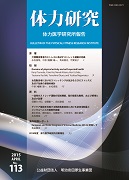All issues

Volume 103
Displaying 1-3 of 3 articles from this issue
- |<
- <
- 1
- >
- >|
-
[in Japanese], [in Japanese], [in Japanese], [in Japanese]2005Volume 103 Pages 1-9
Published: 2005
Released on J-STAGE: July 26, 2017
RESEARCH REPORT / TECHNICAL REPORT FREE ACCESSThis study examined exercise adherence and effectiveness of physical and psychological functional fitness promotion program for the community-dwelling elderly people who need long-term care. The program consisted of a home-based exercise program and group learning on self-care for physical soreness and disability. Subjects were 29 aged persons(13 males; 75.8 ± 9.5 yrs, BMI 24.7 ± 4.1, 16 females; 73.9 ± 5.1 yrs, BMI 24.7 ± 3.1) in the intervention group and 16 aged persons(3 males; 77.3 ± 9.0 yrs, BMI 24.6 ± 1.3, 13 females; 78.1 ± 6.8 yrs, BMI 24.4 ± 3.4)in the control group. The exercise program was composed of 3steps. For the first step, the subjects learned to realize their physical soreness. The next step was learning methods of caring for their soreness. The last step was to improve the muscle strength. The classes were held twice a week over the period of 3 months. Information on functional fitness, grip strength, TMIG index of competence, geriatric depression scale(GDS) and self efficacy for health promotion scale were obtained using the standardized tests and questinnaire before and after the intervention period.Before the intervention period, the physical fitness level and grip strength in the intervention group did not significantly differ from those in the control group. The program adherence and class participation were 75.9% and 70.3 ± 29.0% at the end of the intervention period, respectively. The intervention group showed significant improvement in functional fitness and grip strength. The improvement of Self-Care working performance, grip strength, TMIG index of competence, and GDS score in the intervention group were significantly higher than those in the control group. These results suggest that the functional fitness promotion program composed of self-care exercise and group learning were effective for improving physical and psychological functional fitness level in community-dwelling elderly people who need long-term care.View full abstractDownload PDF (541K) -
[in Japanese], [in Japanese], [in Japanese], [in Japanese], [in Japane ...2005Volume 103 Pages 10-23
Published: 2005
Released on J-STAGE: July 26, 2017
RESEARCH REPORT / TECHNICAL REPORT FREE ACCESSThe purpose of this study was to evaluate the feasibility and effectiveness of exercise behavior self-monitoring applicable to the prevention of lifestyle-related diseases in community-based health service. The study population consisted of 45 people( 3 males and 42 females) living in a community in Tokyo who met the following criteria: 65 years old or younger, a body mass index( BMI) of 24.2 or greater. The subjects recorded the number of steps taken each day and recorded whether they had performed their target self-determined exercise behavior using A4-format sheets for 5 months( 154 days) from November 2002 to April 2003. The feasibility was evaluated by the submitting rate( defined as the number of submitting sheet divided by 5) and the recording rate(defined as the number of recording day divided by 154). The process was assessed by the changes in the contents of self-monitoring. The effectiveness was assessed by the differences between before and after the intervention period in BMI, 3-minute walk distance, energy expenditure, exercise self-efficacy score and stage of change. Furthermore the relationship between the intervention effect and the intervened energy expenditure estimated by the self-monitoring recordings was examined. 1)The submitting rate was 99.6% and the recording rate was 95%. 2)The target exercise behavior, the number of step and the intervened energy expenditure significantly increased after the intervention period. 3)The BMI, 3-minute walk distance, energy expenditure, exercise self-efficacy score and stage of change significantly improved after the intervention period. 4)The change in the number of steps before and after the intervention was significantly greater in those who submitted all the recording sheets than in those who did not. 5)The stage of change significantly progressed after the intervention period in those who were in preparation stage before the intervention and submitted all the recording sheets. 6)The contribution rate of the intervened energy expenditure for the differences in BMI was estimated to be 27.3% and that for the differences in energy expenditure was estimated to be 20.1%. The results indicated that performing exercise self-monitoring promoted the changes in exercise behavior and contributed the maintenance. The data also indicated that the estimated intervened energy expenditure could predict the intervention effects. Therefore, the exercise self-monitoring was a practical and effective method of supporting behavioral changes for the prevention of lifestyle-related diseases in community-dwelling middle-aged and elderly people.View full abstractDownload PDF (1559K) -
[in Japanese]2005Volume 103 Pages 24-30
Published: 2005
Released on J-STAGE: July 26, 2017
RESEARCH REPORT / TECHNICAL REPORT FREE ACCESSDownload PDF (375K)
- |<
- <
- 1
- >
- >|